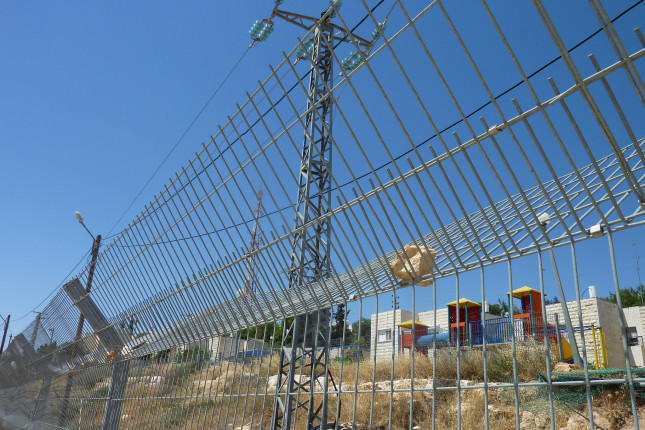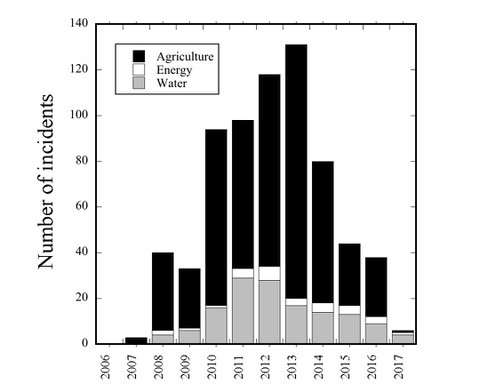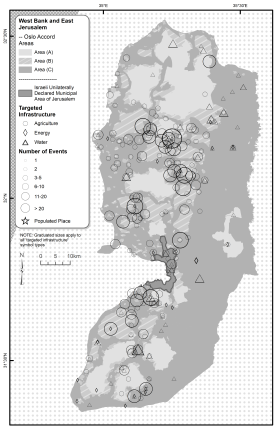-
Targeting Infrastructure Undermines Livelihoods in the West Bank

In many Middle Eastern wars, targeting civilian infrastructure has become all too common. As we documented in a previous article, both state and non-state actors in wars since 2011 in Libya, Syria, and Yemen have targeted water, sanitation, and energy facilities to displace urban populations, punish civilians, and render local attempts to provide public services untenable. Destroying environmental and civilian infrastructure directly undermines livelihoods and human security.
It is not just the post-2011 wars, however, in which the direct and indirect targeting of civilian and environmental infrastructure has figured prominently. Many conflicts in the Middle East are of long duration, characterized by periods of direct occupation or external support for an array of proxy forces, as has been the case in Lebanon, Israel/Palestine, Iraq, southeastern Turkey, Syria, Libya, Yemen, and the Western Sahara. In light of this variation in the types of conflict in the region, we explored the effects of protracted conflict and prolonged occupation on civilian and environmental infrastructure in the West Bank and Gaza Strip between 2006 and 2017, and examined how humanitarian actors have responded to these conditions. In our recently published article, “Targeting Infrastructure and Livelihoods in the West Bank and Gaza,” in International Affairs, we show how repeated cycles of direct and indirect targeting of civilian and environmental infrastructures exacts a heavy cost on human welfare and livelihoods in situations where protracted conflict is coupled with prolonged occupation.
Slow Violence and Prolonged Occupation in Israel/Palestine
The UN Security Council first used the term, “prolonged occupation” with regard to the West Bank and Gaza Strip in 1980—13 years after Israel took control of Gaza from Egypt and the West Bank from Jordan during the 1967 war. A half century later, it is clear that what Ariella Azoulay and Adi Ophir, in their groundbreaking book, The One-State Condition (Stanford University Press, 2013), termed the “occupation regime”—that is, an array of legal, administrative and extra-legal systems that seek to control local populations and resources—has deepened and expanded its reach. Israeli discourse and legal analysis, however, have long been ambiguous about whether the occupation of the Palestinian territories is temporary or protracted, or whether it is even an occupation. The Israeli government has persistently argued that the Fourth Geneva Convention does not apply to the Palestinian territories and refers to the territories as Judea and Samaria, that is, as historically integral parts of a biblical Israel.
In the West Bank, a central feature of the Israeli occupation has been settler expansion to alter demographic balances. In spite of the Oslo Accord negotiations in the mid-1990s, Israeli control over Palestinian livelihoods has deepened through legal restrictions on infrastructural development, the expropriation of Palestinian land, and the expansion of the permit system that restricts the movement of Palestinians in the West Bank. Our analysis finds that the systemic use of legal restrictions, infrastructure destroyed by settlers and state authorities, and permit denials for infrastructure construction are examples of “slow violence”—a term Princeton University scholar Rob Nixon coined in 2011 to describe environmental destruction that unfolds gradually and largely out of sight.
Targeting Civilian Infrastructure in the West Bank
To track how civilian infrastructures in water, energy, and agriculture have been targeted in the West Bank and Gaza, we compiled a database that includes 982 discrete incidents of state and non-state actors targeting infrastructure, drawing on published news articles, UN documents, and human right reports. Our findings for the West Bank illuminate the slow violence impacts of targeting infrastructure over the long term.
Figure 1 breaks down the 685 incidents by year for the agricultural, water, and energy sectors in the West Bank: 516 (75 percent) targeted the agricultural sector, 140 (20 percent) targeted water, and 29 (4 percent) targeted energy in the West Bank.
Figure 1: Infrastructure targeted in the West Bank

Map 1
As the figure and map show, the most targeted sector in the West Bank was agriculture. Attacks on agriculture directly disrupted cultivation and crops and also targeted water and energy infrastructures used for irrigation, planting, and harvesting. In our data, Jewish settlers in the West Bank carried out 65 percent of incidents targeting agriculture. Israeli state authorities carried out the remainder. Nearly 70 percent of the targeted agriculture involved olive and fruit trees. Targeting olive trees epitomizes the slow violence of resource capture in the West Bank, as they are central to Palestinian identity, struggle, and livelihoods.
Despite the creation of the Joint Water Committee to coordinate water management and cooperation between Israel and the Palestinian National Authority, our data also confirms Jan Selby’s findings that numerous restrictions obstruct new water infrastructure development. Besides the many instances where water infrastructures were directly destroyed, Israeli authorities frequently limit infrastructural development in the water sector, primarily in Area C (which makes up more than 60 percent of the West Bank and is an area where Israel retains near exclusive control, including over law enforcement, planning, and construction), by refusing construction permits for building water infrastructure and denying requests to connect Palestinian villages to the water system. Approvals for building wastewater treatment plants were also frequently denied. Although our data show that agriculture and water are the most heavily targeted sectors in the West Bank, we also found a small number of incidents in which the energy sector was targeted. These have ranged from damage caused to electricity transformers to the demolition of newly installed electricity connections, the theft of electricity generators, and destruction of solar panels.
Blocked Humanitarian Aid and Damaged Infrastructure in the West Bank
In efforts to halt the sustained targeting of agriculture, water, and energy infrastructures, Israeli and Palestinian human rights and civil rights groups have frequently invoked provisions of international humanitarian law and international human rights law that apply to occupying powers and protecting civilians and civilian infrastructure. These appeals, however, have largely been ignored. Instead, humanitarian actors and donors face significant restrictions in carrying out humanitarian activities and projects in the West Bank due to the ubiquitous permit system, which requires donors to obtain formal approval from the Israeli civil administration for any infrastructure project.
In our interviews with local NGOs and international humanitarian organizations, they reported that the permit system is the most significant obstacle to investing in or improving civilian infrastructure. In many instances, permits are never granted or the application process drags on indefinitely, preventing humanitarian organizations from undertaking infrastructure repairs and investments designed to prevent civilian displacement. In many instances, Israeli authorities confiscated donor-funded infrastructure, often citing inadequate or lacking permits. The protracted process of applying to the Israeli authorities and waiting for permits that may never materialize obstructs the timely delivery of humanitarian assistance.
Systematic targeting of the water, energy, and agriculture sectors in the West Bank is an important feature of the evolving occupation regime that undermines human security for Palestinian communities. Damage to infrastructure projects and delays in repair and needed investment make life harder for Palestinian civilians who depend on essential infrastructure, with long-term negative implications for human welfare, economic activity, and livelihoods.
This work is part of our larger project analyzing the targeting of environmental and civilian infrastructures across the Middle East and North Africa.
Erika Weinthal is Lee Hill Snowdon Professor of Environmental Policy at the Nicholas School of the Environment, Duke University. Her research focuses on global environmental politics and environmental peacebuilding.
Jeannie Sowers is Associate Professor of Political Science at the University of New Hampshire. Her research focuses on political economy and environmental issues in the Middle East and North Africa.
Sources: International Affairs, Security Dialogue, Targeting of Infrastructure in the Middle East, The One-State Condition, United Nations Office for the Coordination of Humanitarian Affairs, Water Alternatives
Photo Credit: Barrier in the West Bank, June 2011, courtesy of Flickr user DYKT Mohigan.
 A Publication of the Stimson Center.
A Publication of the Stimson Center.





